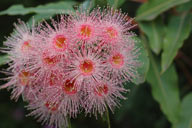In Flower This Week
A news sheet prepared by a Gardens' volunteer.
Numbers before each plant refer to temporary IFTW labels in the gardens.
Numbers in square brackets [ ] refer to garden bed Sections. Plants in flower are in bold type.
View past issues of 'In Flower This Week'.
16 - 29 March 2016
Corymbia 'Summer Beauty' click for larger image |
We will take a short walk today from the Visitors Information Centre (VIC) to the environs of the cafe.
- As you leave the VIC notice on your right Corymbia 'Summer Beauty' [Section 174], a small bushy tree with long green leaves, attractive buds and glorious pink fluffy flowers.
- Close by, also on your right, is Corymbia 'Summer Red' [Section 174], another spectacular small eucalypt with bright red flowers and beautiful bud formations.
- Cross the bridge and go past the café to see on your left Banksia 'Stumpy Gold' [Section 131], with fine, toothed linear foliage and masses of short gold cones with rusty red styles. This plant is a dwarf cultivar of Banksia spinulosa var. collina that was selected by Richard Anderson of Merricks Nursery in Victoria from material collected on the Central Coast of New South Wales.
- Epacris longiflora [Section 131], or Native Fuchsia on your left, has thin tubular red flowers with white tips on a small prickly bush. This plant belongs to the heath family and its native range extends from the central coast of New South Wales to southern Queensland.
- Further on your left is Epacris longiflora 'Nectar Pink' [Section 131], a very floriferous small shrub covered in slender pink bell flowers with white tips.
- On your right is Correa 'Summer Belle' [Section 240] with pink bell flowers with greenish tips. This cultivar arose from a garden seedling and was developed by Neil Marriott of Stawell, Victoria.
- On your left is Banksia ericifolia 'Golden Girl' [Section 240], a large bush with bright gold cones and upright "heathy" foliage that is more blue-green than that of other B. ericifolia cultivars.
- Turn right down the hill towards the Education Building to see on your right a prostrate form of Banksia integrifolia var. integrifolia [Section 240], or Coast Banksia, a vigorous groundcover with dark green leaves with silver backs. There are upright yellow-green cones on this versatile and hardy plant native to coastal eastern Australia.
- Turn right again to see on your left Callistemon viminalis 'Hannah Ray' [Section 240], with grey-green weeping foliage and red "bottlebrush" flowers. This is a long-flowering and reliable cultivar in the garden.
- Further on your right is a species of Zieria [Section 240], a neat bush of green foliage covered in tiny pinkish flowers.
- Low on your right is Crowea saligna 'Rosy Glow' [Section 240], a small neat bush with pink star flowers.
- On your left is Grevillea 'Robyn Gordon' [Section 240], with deeply-divided green foliage and red/pink flowers. This plant is very popular and has been planted widely in Australia and other countries. It is a chance hybrid from the garden of the late David Gordon of Myall Park, Glenmorgan, Queensland. David Gordon was a plant collector with an extensive collection of Grevillea species which (according to legend) he planted in alphabetical order by species. This meant that the Queensland species Grevillea banksii was next to the Western Australian G. bipinnatifida. A plant that was later to become the cultivar 'Robyn Gordon' (named after the Gordons' daughter) arose by chance near these two parent species.
- On your right is Correa alba [Section 240], or White Correa, with creamy-white bell flowers on dull green foliage with silver backs. This shrub is found in the wild in the coastal regions of south-eastern Australia.
- On your left is a species of Banksia [Section 240], with stunning new brown cones with reddish tops.
- Also on your left is another species of Banksia [Section 240], with tapered green cones with brown tips on an open bush of green foliage
Rosalind Walcott
![Director of National Parks [logo]](../../../../images/dnp_90px.gif)







